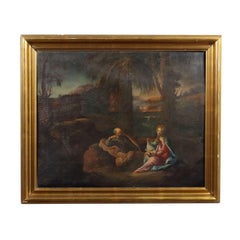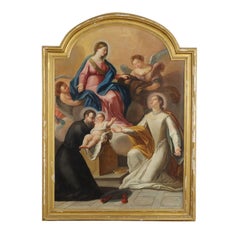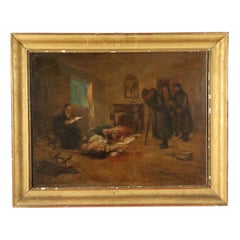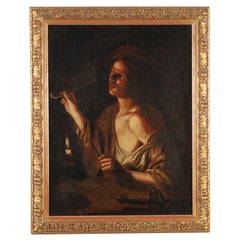Want more images or videos?
Request additional images or videos from the seller
1 of 18
UnknownMythological Subject, Italy XVII Century, The Tale of Apollo and Marsyas1600s
1600s
$12,009.09List Price
About the Item
- Creation Year:1600s
- Dimensions:Height: 51.19 in (130 cm)Width: 105.52 in (268 cm)Depth: 5.12 in (13 cm)
- Medium:
- Period:
- Condition:
- Gallery Location:Milan, IT
- Reference Number:1stDibs: LU680310867072
About the Seller
4.8
Vetted Professional Seller
Every seller passes strict standards for authenticity and reliability
Established in 2017
1stDibs seller since 2017
126 sales on 1stDibs
Typical response time: 2 hours
Authenticity Guarantee
In the unlikely event there’s an issue with an item’s authenticity, contact us within 1 year for a full refund. DetailsMoney-Back Guarantee
If your item is not as described, is damaged in transit, or does not arrive, contact us within 7 days for a full refund. Details24-Hour Cancellation
You have a 24-hour grace period in which to reconsider your purchase, with no questions asked.Vetted Professional Sellers
Our world-class sellers must adhere to strict standards for service and quality, maintaining the integrity of our listings.Price-Match Guarantee
If you find that a seller listed the same item for a lower price elsewhere, we’ll match it.Trusted Global Delivery
Our best-in-class carrier network provides specialized shipping options worldwide, including custom delivery.You May Also Like
Czech Painting of Rabbis
Located in San Francisco, CA
Fantastic realist painting of two Rabbis having a discussion. Great detailed painting signed Pavlik. There are several listed Pavlik's not sure which one this could be done by. Oil o...
Category
Mid-20th Century Realist Figurative Paintings
Materials
Oil
French Cubist Portrait of a young girl
By Alain Mettais Cartier
Located in Woodbury, CT
Mattais Cartier (French, circa 1910–1960)
Cubist Figure with Raised Arm, 1947
Oil on canvas, signed and dated lower right
Executed in 1947, this bold and architectonic composition ...
Category
1940s Cubist Figurative Paintings
Materials
Oil
English 19th century figure scene with fisherman helping ladies on to a boat
Located in Woodbury, CT
Outstanding quality Victorian Genre scene of some fishermen helping some high-class ladies on to their small boat.
The style is a type of the High-end Victorian Genre scene. Painters like Tissot, Millais, the Pre-Raphaelites, and other genre painters all painted in this high-quality style.
The painting is signed and dated lower left and is an oil on canvas, but alas the signature is not obvious enough to know the painter.
The history of the painting is that it came from an English private collection of paintings...
Category
1860s Victorian Figurative Paintings
Materials
Oil
$3,600
Free Shipping
H 36 in W 32 in
19th century English warship off the Italian, Mediterranean coast, with village
Located in Woodbury, CT
Outstanding 19th century English warship off the Italian, Mediterranean coast, with village, mountains and hills.
A very interesting and somewhat unique oil on slate depicting an English ship at anchor in what looks like an Italian or Mediterranean coastline.
The piece has influences from John Thomas Serres...
Category
1840s Victorian Figurative Paintings
Materials
Slate
$2,950
Free Shipping
H 16 in W 21 in
Black & White Painting of Victoria Embankment London by British Urban Artist
By Angela Wakefield
Located in Preston, GB
Black & White Painting of Victoria Embankment London - a unique original from leading British Cityscape Artist, Angela Wakefield.
Art measures 24 x 24 inches
Frame measures 29 ...
Category
2010s Modern Landscape Paintings
Materials
Paint, Cotton Canvas, Canvas, Gesso, Oil, Acrylic
$8,604
Free Shipping
H 29 in W 29 in D 1.75 in
Joseph Wilhelm Suhs Fisherwoman
Located in San Francisco, CA
Joseph Wilhelm Suhs: 1864-1938. Listed German artist with auction records over $4500. This oil on canvas of a lovely woman bringing in the catch of the day measures 18 3/4 inches hig...
Category
Late 19th Century Figurative Paintings
Materials
Oil
Viola - Oil Paint - 2000
Located in Roma, IT
Oil on canvas realized in 2000.
Hand signed, titled and dated on rear.
Includes a contemporary wooden frame cm. 53x38.
Very good condition except for some very minor losses of color.
Category
Early 2000s Contemporary Figurative Paintings
Materials
Oil
Vase of Flowers - Oil Paint - 1990s
Located in Roma, IT
Oil on canvas realized by an italian painter in 1990s and hand signed "De Silvestri".
Very good condition.
Category
1990s Contemporary Figurative Paintings
Materials
Oil
Rachele - Oil Paint - 2000
Located in Roma, IT
Oil on canvas realized in 2000.
Hand signed, titled and dated on rear.
Includes a contemporary wooden frame cm. 53x38.
Very good condition except for some very minor losses of color.
Category
Early 2000s Contemporary Figurative Paintings
Materials
Oil
The Soul of Picasso and the Artists of the 20th Century - Oil Paint - 1990s
Located in Roma, IT
Oil on board realized by Paolo Scheggi (1955) in 1990s.
Hand signed.
Titled on rear.
With a painted wooden frame which is part of the painting.
Very good condition.
Paolo Schegg...
Category
1990s Contemporary Figurative Paintings
Materials
Oil
$757 Sale Price
20% Off
H 14.18 in W 16.42 in D 0.4 in
More From This Seller
View AllRest on the Flight into Egypt Oil on Canvas XVIII-XIX Century
Located in Milan, IT
Oil painting on canvas. XVIII -XIX century. The sacred theme in this scene takes on a familiar connotation, full of very earthly tenderness and intimacy: in an almost exotic context, which evokes an oasis in the desert...
Category
Late 18th Century Other Art Style Figurative Paintings
Materials
Oil
Madonna with Child Angels and Saints, XVII-XVIIIth century
Located in Milan, IT
Oil painting on canvas. Northern Italian school of the 17th-18th century. The work of a devotional nature, sees the Madonna, seated on the clouds and assisted by two angels who suppo...
Category
Late 17th Century Other Art Style Figurative Paintings
Materials
Oil
The Tragic Return Oil on Canvas Late 1800s
Located in Milan, IT
Oil on canvas. It probably depicts a tragic anti-Semitic event. On the right, a wounded soldier in Russian uniform is witnessing the dramatic scene of a slaughtered family while the ...
Category
19th Century Figurative Paintings
Materials
Oil
Painting Young man lighting a pipe 18th century
Located in Milan, IT
Oil on Canvas.
The painting offers a half-length portrait of a young man in deshabillé who is lighting his pipe by drawing fire with a stick from the candle placed in front of him o...
Category
18th Century Other Art Style Figurative Paintings
Materials
Oil
$4,354 Sale Price
20% Off
Painting with The Holy Family at the Table
Located in Milan, IT
Oil on Canvas. Central Italian school of the 17th century.
The unusual and peculiar depiction presents on the left the three figures of the Holy Family, with Jesus already a child, s...
Category
17th Century Other Art Style Figurative Paintings
Materials
Oil
$7,193 Sale Price
20% Off
Panel painting Annunciation 16th century
Located in Milan, IT
Oil on Board. Central-Italian school of the second half of the 1500s.
The sacred scene of the Annunciation sees the two protagonist figures placed in the foreground in an interior th...
Category
16th Century Other Art Style Figurative Paintings
Materials
Oil
$15,617 Sale Price
20% Off
Recently Viewed
View AllMore Ways To Browse
The Servant
Apollo Art
Plays The Flute
Antique Paintings Mythological
Oil Painting Mythological
Apollo Painting
Goddess Minerva
Midas Watch
Minerva Watch
Fisherman Paintings
Oa Fine Art
Orientalist Frame
Oil Painting Of A Swan
Swimming Painting
Rabbi Art
Haute Couture Painting
Painted Backdrop
Bezalel School Jerusalem



